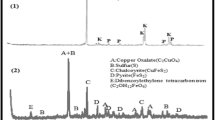Abstract
Wood treated with CCB (chromated copper borate) has an expected service life of 20–50 years, depending on conditions of service and method of treatment. After this period, treated wood is discarded as special waste. Due to toxic elements (Cu, Cr, and B) in such treated wood, burning and landfill disposal are not considered as environmentally sound solutions. Chemical extraction seems more promising. The principle of the method is to convert fixed biocides in wood into soluble form and leach them out of the wood. In order to elucidate this process, copper(II) sulfate, potassium dichromate, and CCB-treated samples were leached using five different agents, namely, water, an aqueous solution of oxalic or acetic acid, and an aqueous solution of oxalic or acetic acid with ammonia. Afterwards, the amounts of leached copper and chromium were determined. In a parallel experiment, electron paramagnetic resonance measurements of wet- and dry-leached and unleached samples were performed in order to determine the paramagnetic complexes that were formed. The highest chromium leaching was achieved with the aqueous solution of oxalic acid, as chromium was converted into water-soluble chromium oxalate. While the mixture of oxalic acid and ammonia resulted in the highest copper leaching, EPR observation revealed that in this case water-soluble complexes of copper, oxalic acid, and ammonia were formed. We found out that oxalates formation is not the only mechanism responsible for copper or chromium leaching. High acidity may play an important role too.




Similar content being viewed by others
References
Clausen CA, Smith RL (1998) Removal of CCA from treated wood by oxalic acid extraction, steam explosion, and bacterial fermentation. J Ind Microbiol Biotechnol 20:251–257
Cole FA, Clausen CA (1996) Bacterial biodegradation of CCA-treated waste wood. In: The use of recycled wood and paper in building applications, Proceedings no. 7286, pp 201–204
Cooper PA (1993) Leaching of CCA: Is it a problem? Disposal of treated wood removed from service. In: Proceedings: Environmental considerations in the manufacture, use and disposal of preservative treated wood, pp 45–54
European Committee for Standardization (1989) Wood preservatives: Determination of the toxic values against wood destroying basidiomycetes cultured an agar medium. EN 113, Brussels, p 14
European Committee for Standardization (1992) Wood preservatives – Accelerated ageing of treated wood prior to biological testing – Leaching procedure. EN 84, Brussels, p 14
European Committee for Standardization (1994) Wood preservatives – Methods for measuring losses of active ingredients and other preservative ingredients from treated timber. Part 2: Laboratory method for obtaining samples for analysis to measure losses by leaching into water or synthetic sea water. EN 1250, Brussels, p 16
Green F, Larsen MJ, Winandy JE, Highley TL (1991) Role of oxalic acid in incipient brown-rot decay. Mater Org 26:191–213
Huang C, Cooper PA (2000) Cement-bonded particleboards using CCA-treated wood removed from service. For Prod J 50:49–56
Hughes AS (1999) Studies on the fixation mechanisms, distribution and biological performance of copper based timber preservatives. PhD thesis, Imperial College of Science, Technology and Medicine, London, p 313
Hughes AS, Murphy RJ, Gibson JF, Cornfield JA (1992) Examination of preservative-treated Pinus sylvestris using electron paramagnetic resonance. The international research group on wood preservation, Document IRG/WP 92-3710, p 15
Humar M, Petrič M, Pohleven F (2001a) Leaching of copper from wood treated with copper based wood preservatives. Wood Ind 52:111–116
Humar M, Petrič M, Šentjurc M (2001b) Influence of moisture content on EPR parameters of copper in impregnated wood. Holz Roh- Werkst 59:254–255
Humar M, Petrič M, Pohleven F, Šentjurc M, Kalan P (2002a) Changes of copper EPR spectra during exposure to wood rotting fungi. Holzforschung 56:229–238
Humar M, Petrič M, Pohleven F, Šentjurc M (2002b) EPR changes, O2 consumption and CO2 evolution during fixation of chromium based wood preservatives in wood. Wood Sci Technol 36:309–318
Jellison J, Connolly J, Goodell B, Doyle B, Illman B, Fekete F, Ostrfsky A (1997) The role of cations in the biodegradation of wood by the brown rot fungi. Int Biodeterioration Biodegradation 39:165–179
Kartal SN, Clausen CA (2001) Effect of remediation on the release of copper, chromium and arsenic from particleboard made from CCA treated wood. The international research group on wood preservation, Document IRG/WP 01-50170, p 17
Pohleven F, Šentjurc M, Petrič M, Dagarin F (1994) Investigation of ammoniacal copper(II) octanoate in aqueous solutions and its determination in impregnated wood. Holzforschung 48:371–374
Ruddick JNR, Xie C, Herring FG (2001) Fixation of amine copper preservatives. Part 1. Reaction of Vanillin, a lignin model compound with monoethanolamine copper sulphate solution. Holzforschung 55:585–589
Sharp RF (1975) The interaction of fungi, wood preservatives and wood. The moment of copper by hyphae as observed with a model technique. Wood Sci Technol 9:99–111
Shiau RJ, Smith RL, Avellar B (2000) Effects of steam explosion processing and organic acids on CCA removal from treated wood waste. Wood Sci Technol 34:377–388
Skoog DA, West DM, Holler FJ (1992) Fundamentals of analytical chemistry. Saunders College Publishing, Fort Worth, USA, pp 118–143
Srivastava PC, Banerjee S, Banerjee BK (1980) Magnetic and spectroscopic behaviour of some copper oxalate complexes. Indian J Chem 19A:77–79
Stephan I, Peek RD (1992) Biological detoxification of wood treated with salt preservatives. The international research group on wood preservation, document IRG/WP 3717-92, p 12
Stephan I, Leithoff H, Peek RD (1996a) Microbial conversion of wood treated with salt preservatives. Mater Organ 30:179–199
Stephan I, Peek RD, Nimz H (1996b) Detoxification of salt-impregnated wood by organic acids in a pulping process. Holzforschung 50:183–187
White C, Sayer JA, Gadd GM (1997) Microbial solubilization and immobilization of toxic metals: key biogeochemical processes for treatment of contamination. FEMS Microbiol Rev 20:503–516
Zhang J, Kamdem DP (2000) EPR analysis of copper amine treated southern pine. Holzforschung 54:343–348
Author information
Authors and Affiliations
Corresponding author
Rights and permissions
About this article
Cite this article
Humar, M., Pohleven, F. & Šentjurc, M. Effect of oxalic, acetic acid, and ammonia on leaching of Cr and Cu from preserved wood. Wood Sci Technol 37, 463–473 (2004). https://doi.org/10.1007/s00226-003-0220-6
Received:
Published:
Issue Date:
DOI: https://doi.org/10.1007/s00226-003-0220-6




